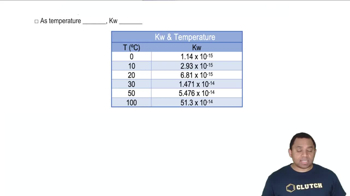Here are the essential concepts you must grasp in order to answer the question correctly.
Vapor Pressure
Vapor pressure is the pressure exerted by a vapor in equilibrium with its liquid or solid phase at a given temperature. It reflects the tendency of particles to escape from the liquid phase into the vapor phase. The higher the temperature, the greater the vapor pressure, as more molecules have sufficient energy to overcome intermolecular forces.
Recommended video:
Raoult's Law and Vapor Pressure
Equilibrium Constant (Kp)
The equilibrium constant (Kp) is a numerical value that expresses the ratio of the concentrations of products to reactants at equilibrium for a gas-phase reaction, with each concentration raised to the power of its stoichiometric coefficient. Kp is temperature-dependent and provides insight into the extent of a reaction; a larger Kp indicates a greater concentration of products at equilibrium.
Recommended video:
Equilibrium Constant Expressions
Temperature Dependence of Kp
The value of Kp varies with temperature due to changes in the kinetic energy of molecules and the equilibrium position of the reaction. For endothermic reactions, Kp increases with temperature, while for exothermic reactions, Kp decreases. Understanding this relationship is crucial for predicting how changes in temperature affect the equilibrium state of a reaction.
Recommended video:
Kw Temperature Dependence
 Verified step by step guidance
Verified step by step guidance


